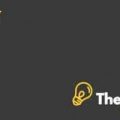
Paediatric orthopaedic clinic at children's hospital of western Ontario Case Solution
Activity Utilization rate/variability under capacity
From the following analysis, it is determined that Paediatric Orthopaedic was looking to minimize the waiting times through the use of additional machine, which would allow to maximize the average utilization rate as well as reduced the variability of the average full as well as follow-up patients. An analysis regarding the use of utilization rates of each process as well as labor indicates that there are some variations in particular results, which hindered the overall activity of utilizing the desire minutes to serve the particular patient’s overtime.
However, due to lack of patient serving as well as direct costs involved the high amount of salaries to the particular workers of each department, it seems that an addition of a machine would allow reducing at least 25% of waiting times that each patient suffered. So it has been determined that a hospital would save 20% of wait time accordingly.
| Utilization rate at each step of process | |
| Full patients | |
| Full-time workers | 3666 |
| Number of patients | 80 |
| Utilization per patients served | 45.83 |
| Utilization rate | 57% |
| Follow-up patients | |
| Full-time workers | 3666 |
| Number of patients | 48 |
| Utilization per patients served | 76.39 |
| Utilization rate over full patients | 33.3% |
| Economic costs | 30.56 |
The results also indicated that annual salaries of workers would be extracted into monthly basis, where average monthly salaries of all the workers would be 3,666. Thus they would be divided by the number of patients in order to calculate the average utilization amount per patient served or in other words, an average value of cost per patient would be incurred based on the particular numbers. These values would be varied according to the changes in the numbers of patients per season or to attend for treatment.
On the other side, the follow-up patients would be based on the 60% of all the patients involved in an activity process. Therefore, the variations occurred in a particular process would be different from the new patients because of the fact that a filter activity of the complex treatment would be incurred to utilize the percentage that would be severe and much needed for the hospital to generate in order to determine the average follow-up process.
| Appointment utilization rate | |
| Active appointments | 70% |
| Rare appointments | 30% |
| Full patient utilization rate | 57% |
| Active appointments | 40.10% |
| Rare appointments | 17.19% |
In a particular table, it seems that an estimated 70% of appointments would be considered as an active process under which there would be a greater possibility to utilize the patient’s applications accordingly. On the other side, rare appointments would be included after 11:30 am, which shows that there would be a probability that the patients would be less involved in the follow-up process or contribute to a part of the treatment accordingly.
Control the sources of variability
The sources of variability would be controlled by increasing the patient’s involvement as well as staff requirement, which could allow handling the utilization rate over the expected one and to increase the ratio of patient treatments through including an additional number of staff members. This would achieve the overall organizational goals and to reduce the waiting times near to 20% of the actual one.
Bottleneck and capacity constraints
From the analysis, it is concluded that a bottleneck under the given process is analyzed through the wait time involved for each patient. Thus it has been analyzed that due to the lack of machines and staff facilities, it can be said that these would be inversely proportional to the wait time. This means that a more time would consider a less staff performance and lack of additional machines.....................
This is just a sample partial case solution. Please place the order on the website to order your own originally done case solution.













